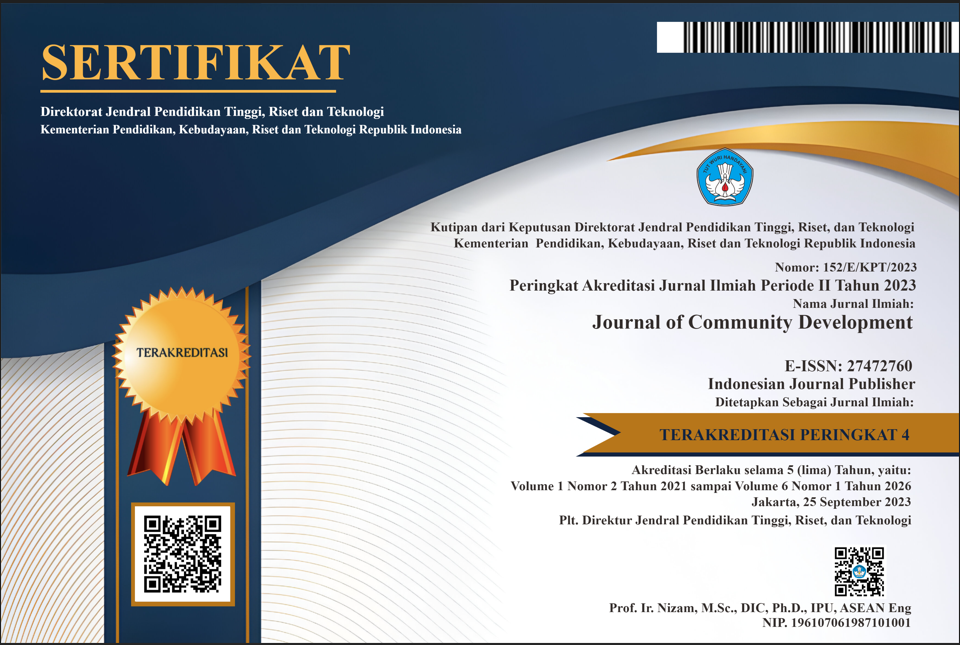Peningkatan Kesadaran Masyarakat Terhadap Kebencanaan Melalui Evaluasi Program Desa Tangguh Bencana (DESTANA) di Desa Sukaraja, Kabupaten Lampung Selatan
DOI:
https://doi.org/10.47134/comdev.v5i1.202Keywords:
Disaster Resilient Village, Evaluation, Sukaraja VillageAbstract
Indonesia, as a country with two-thirds of the ocean, is located at the confluence of three major tectonic plates, namely Indo-Australia, Pacific and Eurasia, making it vulnerable to natural disasters such as megathrusts on the west and south coasts and megathrusts in the north and east that can trigger tsunamis. Lampung Province is one of the areas with high disaster risk based on the Indonesian Disaster Prone Index (IRBI). Therefore, the government has adopted the Destana program as a community-based disaster risk reduction effort. Sukaraja Village, located in South Lampung Regency, faces disaster threats such as landslides, tidal floods and tsunamis. The Destana program has been implemented in this village since 2012 by the South Lampung Regional Disaster Management Agency (BPBD). To evaluate this program, this community service uses the CIPP (Context, Input, Process, Product) evaluation model which includes evaluating the context, input, process, and product of the program with mixed methods. The results of community service show that the objectives of the Destana program in Sukaraja Village are appropriate in dealing with disaster risk. Although there are still some efforts that have not been implemented and unmet deficiencies in program resources and strategies, the Destana program as a whole has been running well. However, there are shortcomings in terms of issuing a Decree (SK) that supports Destana activities, which has an impact on access to village funds. Monitoring and evaluation of this program has been carried out by BPBD, but not yet by village officials. Sukaraja Village has shown results in implementing the Disaster Resilient Village program since 2012, although there are still aspects that need to be improved.
Downloads
References
Badan Meteorologi Klimatologi dan Geofisika Tahun 2017
BNPB. (2012). Peraturan Kepala BNPB, Pedoman Umum Pengkajian Bencana Badan Nasional Penanggulangan Bencana. Jakarta: Badan Nasional Penanggulangan Bencana.
BPBD Provinsi Lampung
Creswell, John W.2015,Pengabdian masyarakat Kualitatif dan Desain Riset:memilih di antara lima pendekatan (edisi ke-3).Pustaka Pelajar, Yogyakarta..
Indeks Risiko Bencana Indonesia Tahun 2022.
Mahmudi, I. (2011). CIPP: Suatu model evaluasi program pendidikan. At-Ta'dib, 6(1).
Peraturan Kepala Badan Nasional Penanggulangan Bencana Nomor 01 Tahun 2012 Tentang Pedoman Umum Pengkajian Risiko Bencana.
Peraturan Kepala Badan Nasional Penanggulangan Bencana Nomor 01 Tahun 2012 Tentang Pedoman Umum Pengkajian Risiko Bencana.
Peraturan Kepala Badan Nasional Penanggulangan Bencana Nomor 02 Tahun 2012 Tentang Pedoman Umum Pengkajian Risiko Bencana.
Rencana Kontijensi Desa Sukaraja Tahun 2020.
Savila, V. I., Rachmawati, T. A., & Subagiyo, A. (2019). Analisis Evaluasi program DESTANA (Desa Tangguh Bencana) Di Pulau Giligenting Kabupaten Sumenep. Planning for Urban Region and Environment Journal (PURE), 8(4), 43-52.
Stufflebeam, D. (2001). Evaluation models. New directions for evaluation, 2001(89), 7-98.
Undang- Undang Republik Indonesia Nomor 24 Tahun 2007 tentang penanggulangan bencana.
Wirawan. (2013). Evaluasi: Teori, Model, Standar, Aplikasi dan Profesi. Jakarta: Rajagrafindo persada
Downloads
Published
How to Cite
Issue
Section
Categories
License
Copyright (c) 2024 Restu Prima Robi, Yudha Rahman

This work is licensed under a Creative Commons Attribution 4.0 International License.







